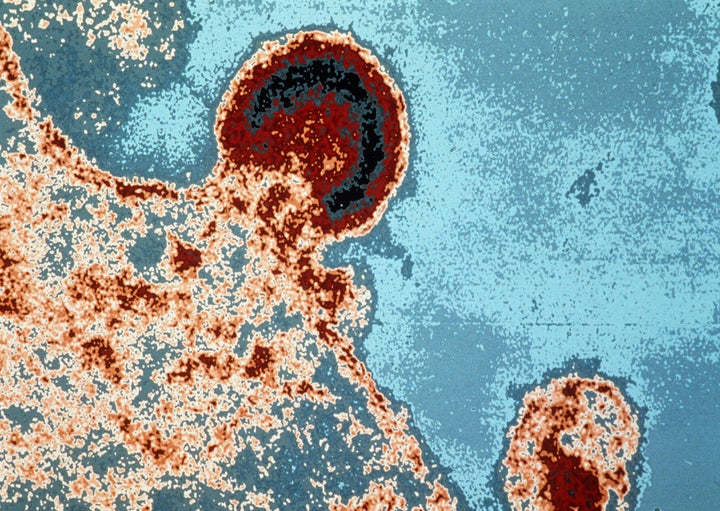
You may feel perfectly healthy, but most of us are walking collections of chronic infections. The Epstein-Barr virus, responsible for mononucleosis, infects nearly everyone. About a third of us are infected with Toxoplasma gondii (or "toxo," for short); this parasite is the reason why pregnant women are warned away from emptying kitty litter boxes. Toxo takes up permanent residence in the brain and has received a lot of media attention recently because of the possible personality changes it might induce. Aside from that, though, most of us infected with toxo feel just fine.
For that we should thank our T cells -- a key component of our immune system arsenal. T cells have evolved to keep toxo and other chronic infections under control and to prevent other pathogens like bacteria or viruses from making us sick. In fact, right now, our immune cells are engaged in an arms race with these microbes; as pathogens evolve sneakier ways of hiding from our immune cells, immune cells like T cells have developed more efficient ways of hunting down pathogens and killing them.
I'm a theoretical condensed matter physicist, so why would I care about how T cells do their job? My interest was aroused through one of those serendipitous collaborations that often emerge in strong research universities. My Penn colleague, Chris Hunter, is an immunologist. He and his coworkers, Tajie Harris and David Christian, were tracking T cells in the brain tissue of toxo-infected mice. They were assuming that the T cells behave like drunken sailors, who pick a random direction every time they take a step. But this didn't seem to fit their data. Because David Christian had collaborated with me before on an entirely different problem, they turned to my group for help.
The drunken sailor problem is a special case of what is known as the random walk problem, and has an illustrious history in physics. The 19th-century botanist Robert Brown used state-of-the art microscopes to look at plant pollen and noticed tiny particles ejected from the pollen grains dancing around in the water. He was intrigued: Could pollen grains propel themselves in order to spread? As a good scientist, he tested this idea by killing the grains in alcohol, and found that the dead particles still performed the same dance, showing that the explanation would rely on physics, not biology.
Brown's curious observation attracted the attention of Albert Einstein. In 1905, the same year Einstein published papers on the theory of special relativity and the explanation of the photoelectric effect (evidence for the quantum nature of light, which won him the Nobel Prize), Einstein published a third paper explaining what was already known as Brownian motion. He realized that the pollen dance Brown had observed was evidence that matter is made of discrete particles. Water molecules continually bombard the pollen particles, sometimes harder in one direction and sometimes harder in another, causing the pollen particles to lurch around. From the mathematics of the drunken sailor problem, he was able to prove the particulate nature of water.
It turns out that the drunken sailor model can explain most random walks. But when my graduate student, Ed Banigan, began analyzing the movements of T cells, he confirmed that T cells are an exception to the rule -- the drunken sailor model doesn't fit. Instead, Ed realized that T cells move in a way more akin to how predators such as sharks or tuna find their prey, via what are known as Lévy walks.
In the drunken sailor model, the sailor always takes steps that are roughly the same length. But in the Lévy walk model there is a broad range of step sizes, so that there is a significant chance that the steps can be very long. This model worked better for the T cell tracks, but still didn't fit the data. After testing dozens of models, we found one that worked beautifully. In this model, the Lévy steps are interspersed with pauses that are usually short but can be arbitrarily long.
We still don't know why T cells have a broad range of pause times between steps or what advantage that might bring. But we have an idea of why they have a broad range of step sizes. It turns out that Lévy walkers are much more efficient than drunken sailors in finding rare targets. So it is possible that our predatory T cells have evolved to develop a more efficient search strategy for their pathogen prey, as sharks and other animal predators have done.
Our findings, published in the journal Nature earlier this week, suggest a host of new questions to be explored. There are many different types of immune cells, each with different functions. Does each type perform a walk that particularly suits its function? Have pathogens evolved random walks that make them harder for T cells to find? T cells are also responsible for hunting down cancer cells. Can we help T cells, or hinder pathogens or cancer cells, by fiddling with their random walk statistics? With so much that remains to be understood, one thing is clear -- it will take the combined efforts of scientists from many different fields to answer these questions.